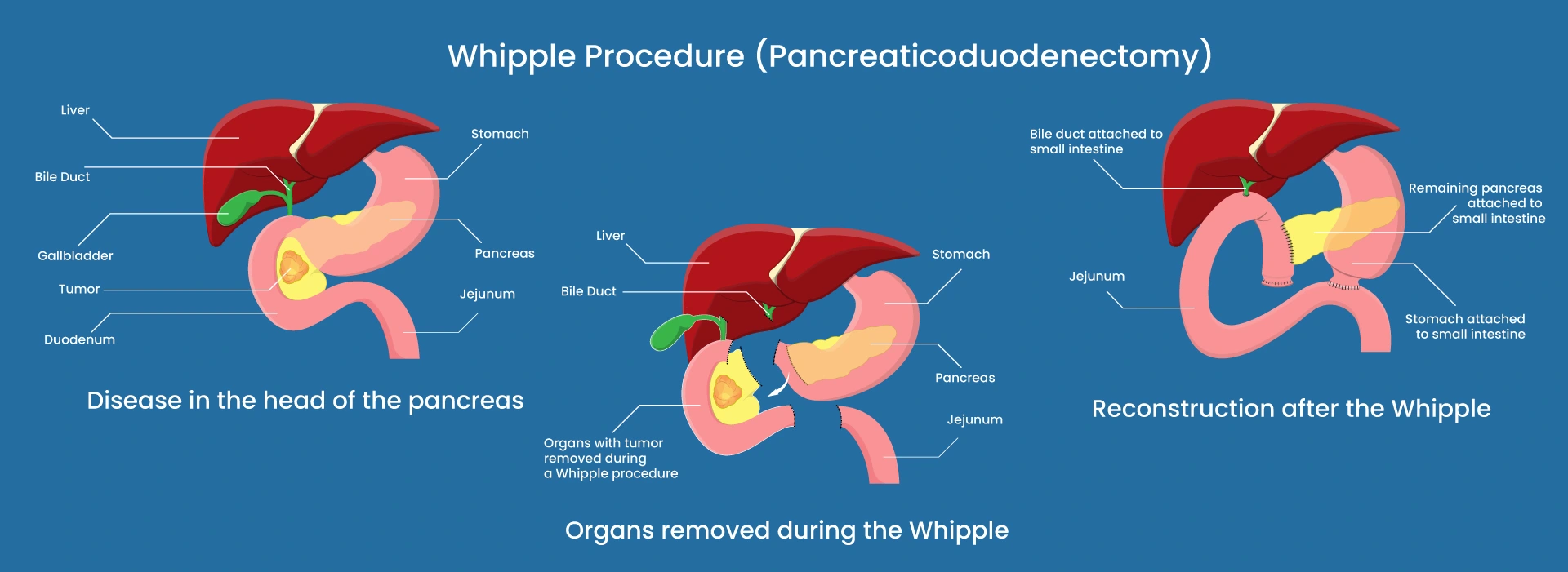We occasionally run into peculiar situations in our daily lives. These circumstances may also alter our regular routine. Among them are illnesses.
Even though when they are healthy, people are unaware of the importance of their daily lives, when they are ill, they can become conscious of the situation when they are unable to carry out even the most basic tasks. People have therefore started looking for cures for their illnesses in an effort to lead normal lives once more.
Problems with the pancreas are one of these disorders. In its later stages, this condition impacts numerous organs. In addition, numerous issues could arise because of how closely the organs in this area are located to one another. The importance of early disease diagnosis can therefore not be overstated.
What is Whipple Surgery?

Patients with tumours of the biliary tract and the 12 finger intestines close to the pancreatic head or with other issues in this area are treated using the whipple technique.
It is crucial that the Whipple surgical method is applied by a surgeon who specialises in this procedure because it is one of the key surgical procedures.
Due to the close proximity of the organs, tumours that develop in the duodenum, biliary tract, and pancreatic head can be challenging to remove. Whipple surgery is a simple and superior healing technique for tumours that develop in these organs because it completely removes the tumor.
Whipple surgery is a procedure in which the head of the pancreas, the 12 finger intestines, and portions of the biliary tract near this area are removed. Fast and effective treatment is crucial because, in some cases, the discomfort can be intolerable for the patient.
Who Can Have Whipple Surgery?
The Whipple method is a technique used when a patient has cancer of the pancreas, duodenum, bile duct, or other benign conditions. The pancreas is a vital organ in the upper abdomen that secretes enzymes that aid in food digestion as well as food, fat, and protein.
A preferred method can also be used to treat conditions like pancreatic cancer, pancreatic tumors, pancreatic cysts, bile duct cancer, neuroendocrine tumors, small intestine cancer, trauma to the pancreas or small intestine, and tumours involving the pancreas and bile ducts.
The tumour is removed using the Izmir Whipple technique, which also stops the tumor’s growth and spread to other organs. When deciding whether or not to perform surgery, doctors consider the disease’s stage of progression. Patients’ responses to surgery also differ from person to person.
How is Izmir Whipple Surgery Performed?
General surgeons perform whipple surgery frequently. A portion of the stomach, a small intestine and a small intestine portion, the head and occasionally the body of the pancreas, a portion of the biliary tract, the gallbladder, lymph nodes surrounding the pancreas, and tumours in these regions are cleaned during Whipple surgery.
Open, laparoscopic, and robotic techniques are used in whipple surgery. When the stomach’s structure is examined, it is clear that the stomach has a self-defense mechanism. The digestive system must understand the significance of this.
Some vessels necessitate more careful procedures during Whipple surgery for pancreatic cancer because the tumour can sometimes affect or engulf the vessels.
The operation lasts between 4 and 8 hours because in addition to these 3 organs, the stomach, small intestine, gall bladder, and lymph nodes are also removed from the body at the junction of the pancreas, bile duct, and 12 finger intestines. Based on the tumor’s stage, this time frame may also be shortened.
What Are the Risks and Complications of Whipple Surgery?
The doctors might not have anticipated every step of the surgery. As a result, each patient might experience a variety of circumstances during surgery. Therefore, it is crucial that the pre-operative controls are properly carried out.
- Whipple surgery can result in bleeding and subsequent blood loss.
- In some circumstances, damage to the organs nearby the site of the surgery may happen.
- It’s possible that the nerves near the site of the Izmir Whipple surgery will suffer damage.
- Body wounds may experience healing disorders.
- Any part of the body can contract an infection.
- Organs in the body are capable of developing fistulas.
- Organs like the liver, kidney, and heart are susceptible to problems with organ failure.
- There could be leaks between the bile duct, stomach, intestine, and incisional hernia.
- There could be intestinal blockages.
- Diabetes, indigestion, and uncontrollable weight loss are just a few possible issues.
- The individual might occasionally experience stomach paralysis.
- It’s possible for issues like diarrhoea and vomiting to bother the person.
- Lung failure following prolonged anaesthesia and intubation is one of the most significant risks associated with Whipple surgery.
- Following Whipple’s surgery, the patient may experience heart failure, one of the irregular heartbeats, or another.
- Following Whipple surgery, the patient may experience kidney failure.

Recovery After Whipple Surgery
Patients typically stay in the hospital for 5 to 7 days, though the length of time depends on the individual patient. It is crucial to regularly perform the required post-operative care in order to heal quickly.
For at least 8 to 12 weeks, the patient should refrain from strenuous activities. The patient can begin his transition back to his regular life if there is no malfunction with the controls. Following Whipple surgery, patients may experience lung issues, wound infections, or embolism (clot removal).
The passage of gastric emptying and the occurrence of currents in the new pathways for the flow of bile and pancreatic secretions are complications that can be seen after Whipple surgery.
For some patients, many of these leaks can be fatal. After surgery, some patients might need to be transferred to intensive care. Additionally, chemotherapy might be required after surgery.
After the first two years, checks will be done every three months, then every six months. Aside from nutrition, it is crucial for someone who has had a Whipple surgery to avoid stress and stop smoking in their daily routines. It is crucial to ask the doctor for specific information regarding other procedures, such as post-operative chemotherapy.
Whipple Surgery Postoperative Life Process
In comparison to many other surgeries, whipple surgery is a more serious procedure. The stage at which the surgery is done and the stage at which the patient is diagnosed are therefore very important. Additionally, the length of the patient’s life following surgery may vary depending on the disease’s stage and the operation’s success.
If early diagnosis and treatment are given, the life expectancy, which is between 3 and 6 months in the most common cases of the disease, can range between 5 and 10 years. Giving precise information on this subject is not possible.
After the Whipple surgery, the specialist doctor who performed the procedure can review the procedure and provide the necessary information.
After a diagnosis of a disease, a sick person’s average life expectancy without surgery is about a year. Careful monitoring and postoperative follow-up can extend life expectancy.
What Should Those Who Have Whipple Surgery Pay Attention To?
- The patient must spend some time in the hospital following the Whipple procedure. It is a serious condition, so complications could develop later. The earliest possible intervention in these complications is crucial.
- Because pancreatic cancer spreads quickly, chemotherapy must be administered in addition to surgery. In general, keeping up for six months is crucial for healing.
- Following up is crucial because the removal of a portion of several organs during surgery has the potential to result in other disorders in the patient. Additionally, it might involve the use of various therapies.
- In order to recover fully from surgery, it is crucial for the patient to pay close attention to their nutritional needs. It is common to experience a loss of appetite after surgery. Due to this, nutrition must be carefully considered.
- The sooner the patient can start to gradually return to his daily life after surgery, the more care he pays to himself during the post-operative period.
- In the days following the Whipple surgery, if symptoms like fever, chills, persistent diarrhoea or vomiting, significant pain, or significant redness at the wound site start to appear, a doctor should be contacted right away.
- The sun’s rays primarily affect wounds. Following surgery, we must keep our wounds out of the sun for an extended period of time.
- After the procedure, the patient should avoid stressful situations.
- All bad habits that put someone’s health in danger, like drinking and smoking, should be avoided.
How Much Are Izmir Whipple Surgery Prices?
Multiple organs can be operated on simultaneously during an Izmir Whipple procedure. Each person may experience this differently. Age, structure, additional illnesses, nutritional status, the location of the cancer, the level of vessel involvement, and many other characteristics play a significant role in how surgeries are applied. Cost of whipple surgery range between 23,000 – 30,000 USD.
The decision to operate depends in large part on the disease’s stage at the time. The procedure is unique as a result.
You can speak to your doctor or the hospital to learn more about the cost of the Izmir Whipple procedure. One of the most crucial qualities is health. The preservation of health is crucial.
The statements on this page are not appropriate for therapeutic use and are completely binding on individuals. You can get information from medical facilities and specialised doctors to treat your health issue and find the best course of action for you.

Associate Professor İsmail SERT finished his specialty training at the Tepecik Training and Research Hospital’s General Surgery Clinic after earning his medical degree from Ege University’s Faculty of Medicine. He spent six months at Geneva University Hospital in Switzerland learning about pancreatic islet cell transplantation, liver and kidney transplantation, liver and pancreas surgery during his residency. At the Liver Transplant Institute in Malatya, he received training as a liver transplant fellow for six months. He then continued his education in Rotterdam, the Netherlands, at the Erasmus MC University Hospital, where he trained in liver, pancreas, and biliary tract surgery, as well as at clinics for kidney and liver transplants. He began the liver transplant programme at the Tepecik Training and Research Hospital’s Organ Transplant Clinic in December 2018 and successfully completed it.

